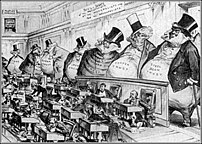SSRN Papers Dealing with IP, Development and Innovation
By Kristopher A. Nelson
in
March 2009
600 words / 3 min.
Tweet
Share
Image via Wikipedia The Patent Lottery: Exploiting Behavioral Economics for the Common Good by Dennis Crouch Lotteries are immensely popular. Players are willing to give the organizer a large monetary cut of every ticket purchase in return for a chance at a jackpot. In some ways, our current patent system operates as a lottery as […]
Please note that this post is from 2009. Evaluate with care and in light of later events.
 Image via Wikipedia
Image via Wikipedia
- The Patent Lottery: Exploiting Behavioral Economics for the Common Good by Dennis Crouch
-
Lotteries are immensely popular. Players are willing to give the organizer a large monetary cut of every ticket purchase in return for a chance at a jackpot. In some ways, our current patent system operates as a lottery as well. Most patents are relatively worthless, while a few are highly valuable. Reaching the major payout of a highly valuable patent takes perseverance in the face of tremendous uncertainty. Like lottery players, small entrepreneurial companies and individuals have shows signs of bounded rationality. In particular, what I call the patent lottery effect is associated with the phenomena of potential innovators overweighting the size of a potential payout on innovation while neglecting to fully consider the actual probability of obtaining that payout. The potential bounded rationality of actors in the patent system challenges our traditional notions of the patent incentive.
In many settings, bounded rationality problems are patched-up with education and paternalism such as in the form of consumer protection. In this article, I take a different approach and instead explore ways that the overconfidence of innovators may alter our choice of innovation policy levers in ways that increase innovation but decrease the monopoly cost of patents.
- Do Patents Perform Like Property? by Michael Muerer and James Bessen
-
Do patents provide critical incentives to encourage investment in innovation? Or, instead, do patents impose legal risks and burdens on innovators that discourage innovation, as some critics now claim? This paper reviews empirical economic evidence on how well patents perform as a property system.
- The Property Rights Movement’s Embrace of Intellectual Property: True Love or Doomed Relationship? by Peter Menell
-
The recent Supreme Court battle over the legal standard for permanent injunctions in patents cases (eBay v. MercExchange) marked an important new front in the Property Rights Movement’s campaign to establish a strict and broad interpretation of property rights and their enforcement. This essay explores whether Professor Richard Epstein’s embrace of intellectual property rights is likely to produce a durable marriage of traditional property rights theory and intellectual property protection or merely represents a fling that will not withstand divisive relational pressures. It shows that philosophical, functional, intellectual, and political tensions stand in the way of a stable or enduring relationship between advocates of strong and unyielding property rights and intellectual property owners. The need for dynamism and adaptability within the intellectual property rights field may well weaken the support for absolutism in property jurisprudence and policy, reinforcing the shift away from the Blackstonian conception of property.
- A New Balance between IP and Antitrust by Mark Lemley
-
In this article, I introduce the interaction between intellectual property (IP) and antitrust law. I describe the ways in which these two important areas of government regulation are and are not in tension, and discuss the history of the relationship between these laws. I argue that IP and antitrust have cycled between over- and under-protection, and that we are currently (and mistakenly) conditioned to think of private property and private ordering as efficient in and of themselves, rather than as efficient only in the context of robust market competition. Further, I argue that antitrust can serve the goals of innovation and dynamic efficiency directly in circumstances in which competition, not monopoly, serves as a spur to innovation. The goal of the IP and antitrust laws should be to seek a robust balance between competition and monopoly in the service of dynamic efficiency. When IP laws are strong, antitrust laws should also be strong, and vice versa.
![Reblog this post [with Zemanta]](http://img.zemanta.com/reblog_c.png?x-id=a43028f5-fb6f-4f26-9764-661d903325c3)